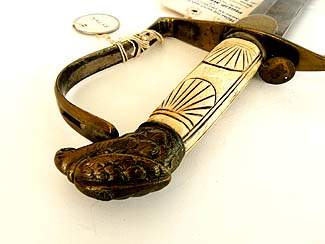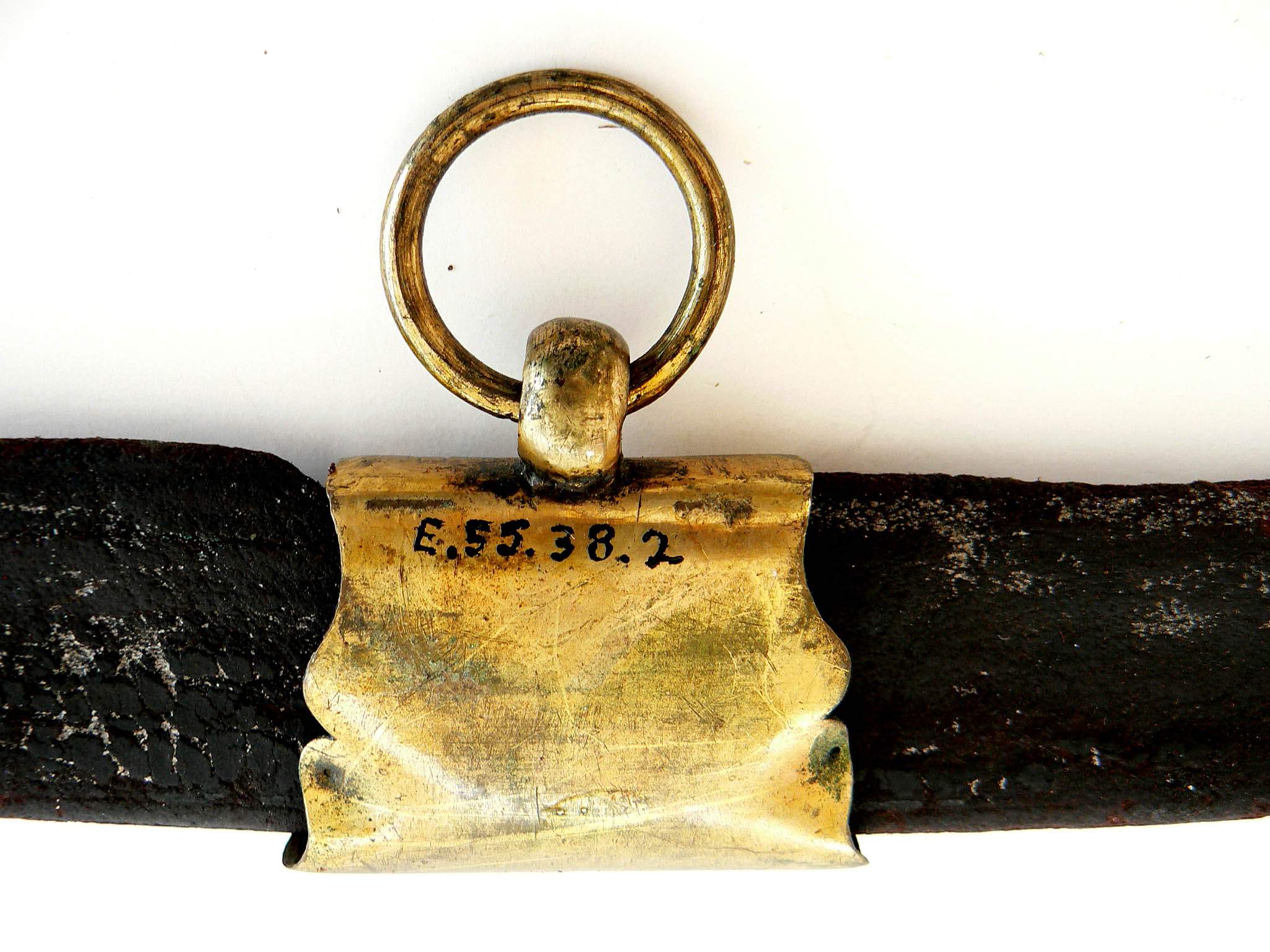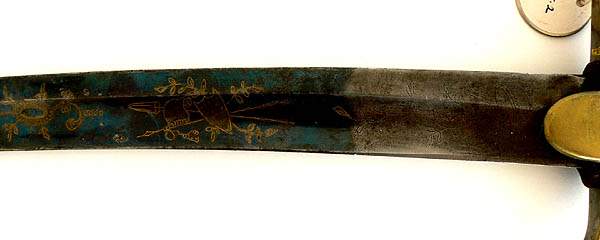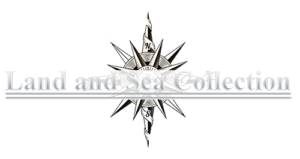
Museum Deaccession
Presented is another very interesting eagle head saber made
for the American Market by E. Richards & Co., likely of Birmingham, England. It has a carved bone grip with
two shell designs on each side, all in excellent condition and tight. The pommel is fitted with a Salter style eagle
in sharp detail with the tang coming through the top of the head. The very sharpness of the features of the
eagle suggests that it was made from an original mold in the early days of production. The only silver wash remaining
is on the inside of the knuckle bow. The knuckle bow has a slot at the rear for a portepee (sword knot).
for the American Market by E. Richards & Co., likely of Birmingham, England. It has a carved bone grip with
two shell designs on each side, all in excellent condition and tight. The pommel is fitted with a Salter style eagle
in sharp detail with the tang coming through the top of the head. The very sharpness of the features of the
eagle suggests that it was made from an original mold in the early days of production. The only silver wash remaining
is on the inside of the knuckle bow. The knuckle bow has a slot at the rear for a portepee (sword knot).
The other distinguishing features are the langets are bare of a design as is
the ferule which are reminiscent of sabers made to the British 1805 regulations and preferred by American Naval officers.
Ref. Page 73 in Mowbray’s, The American Eagle-Pommel Sword.
the ferule which are reminiscent of sabers made to the British 1805 regulations and preferred by American Naval officers.
Ref. Page 73 in Mowbray’s, The American Eagle-Pommel Sword.
Approximately, ninety percent of the bluing and gilding remains on the sharply
curved blade. The accession number, 55.38.2, appears on the front of the reverse side of the crossguard.
curved blade. The accession number, 55.38.2, appears on the front of the reverse side of the crossguard.
PROVENANCE: Sold by Norm Flayderman,
Wallingford Hall, Kennebunk, Maine on September 8, 1956; “From the most important American Sword Collection of Philip Medicus,
New York, New York”. Then to a museum, Accession number 55.38.2. Deacession in 2009 to benefit the “Museum Collection
Fund”.
Wallingford Hall, Kennebunk, Maine on September 8, 1956; “From the most important American Sword Collection of Philip Medicus,
New York, New York”. Then to a museum, Accession number 55.38.2. Deacession in 2009 to benefit the “Museum Collection
Fund”.
Ref. The American Eagle-Pommel Sword, The Early Years – 1794-1830″, by E. Andrew
Mowbray, 1988 on pages 115, 123
Mowbray, 1988 on pages 115, 123
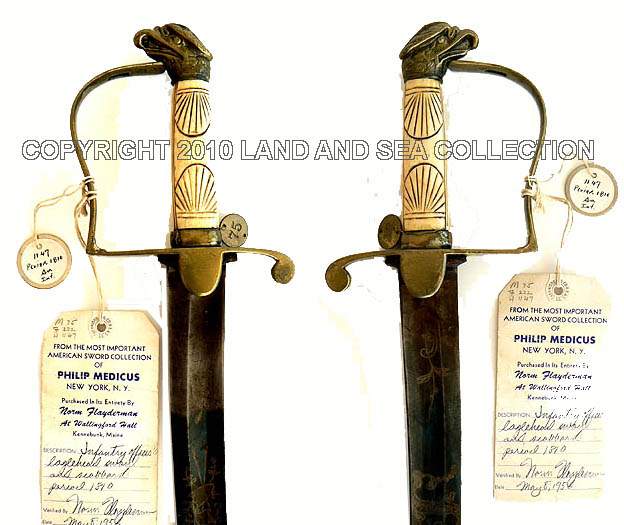 |
|
This style
eagle head is recognizable by its sharp features, open beak, and flattened crest |
BLADE: The sharply curved, single edge 31″ blade, with a single
large, 19″ fuller has most of its bluing and gilding intact. At the reverse in a banner it is marked, “E. Richards
& Co.”. The forward part of the blade is light grey with some darker spots, but nothing objectionable. There are some
small nicks on the forward part of the blade. The etched designs are of American Heraldry consisting of a gilded American
Shield, a flag, and crossed pike on the obverse intertwined with floral symbols and other sprayed foliage on both sides.
large, 19″ fuller has most of its bluing and gilding intact. At the reverse in a banner it is marked, “E. Richards
& Co.”. The forward part of the blade is light grey with some darker spots, but nothing objectionable. There are some
small nicks on the forward part of the blade. The etched designs are of American Heraldry consisting of a gilded American
Shield, a flag, and crossed pike on the obverse intertwined with floral symbols and other sprayed foliage on both sides.
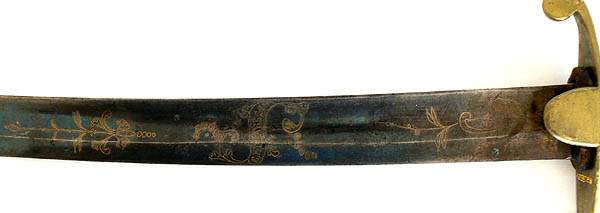   |
|
Gilded American Shield, Flag,
Cannon barrel and leaves with other sprayed foliage on obverse |
THE SCABBARD: The remnants of the black leather scabbard are
two pieces in poor shape. The single brass carrying band is marked with the museum accession number 55.38.2 identifying
this as part of the saber. There are a few age cracks, but the leather is dried out with broken stitching and leather loss.
It is missing two mountings, one at the throat and the other at the tip.
two pieces in poor shape. The single brass carrying band is marked with the museum accession number 55.38.2 identifying
this as part of the saber. There are a few age cracks, but the leather is dried out with broken stitching and leather loss.
It is missing two mountings, one at the throat and the other at the tip.

E. RICHARDS MARK: There is nothing known or reported specifically
by this maker, except that reference to him is made in “The American Eagle Pommel Sword, The Early Years – 1794-1830”, by
E. Andrew Mowbray, 1988 on pages 115, 123 and indirectly elsewhere. He is believed to be related to Thomas Richards of Birmingham,
England and possibly Henry Richards as well as having some connection with Richards – Upson & Co. of New York. However
there is nothing conclusive available. We also have a Richards – Upson five ball spadroon available. See https://landandseacollection.com/id565.html
by this maker, except that reference to him is made in “The American Eagle Pommel Sword, The Early Years – 1794-1830”, by
E. Andrew Mowbray, 1988 on pages 115, 123 and indirectly elsewhere. He is believed to be related to Thomas Richards of Birmingham,
England and possibly Henry Richards as well as having some connection with Richards – Upson & Co. of New York. However
there is nothing conclusive available. We also have a Richards – Upson five ball spadroon available. See https://landandseacollection.com/id565.html
DIMENSIONS: Length overall 35 7/8″
Length of blade 30 7/8″ Width 1 1/4 Thickness 1/4″ Length overall 30 7/8″ The hilt is 5″ Weight Saber 1 lb 9 oz
as is hilt
made for the American Market by E. Richards, Birmingham, England
ADDITIONAL REFERENCES:The American Eagle-Pommel
Sword by E. Andrew Mowbray
The American Sword, 1775-1945, by Harold E. Peterson
Swords & Blades of the American
Revolution by George C. Neumann
